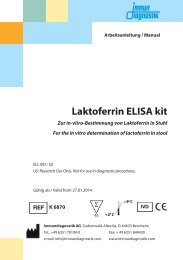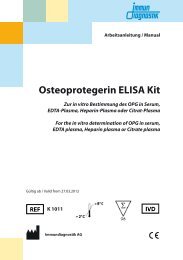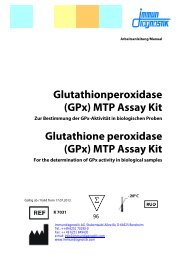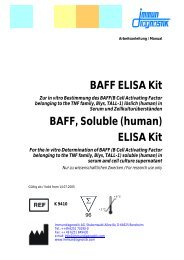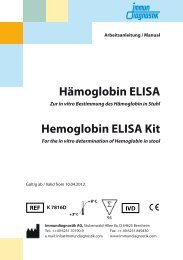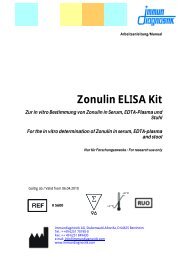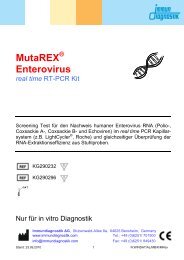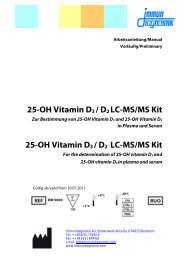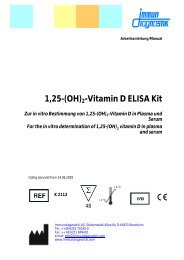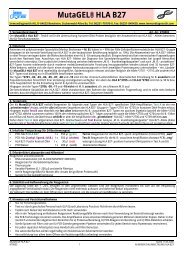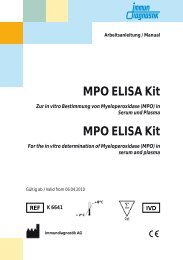HPLC-Analytik Glutathion - bei Immundiagnostik
HPLC-Analytik Glutathion - bei Immundiagnostik
HPLC-Analytik Glutathion - bei Immundiagnostik
Sie wollen auch ein ePaper? Erhöhen Sie die Reichweite Ihrer Titel.
YUMPU macht aus Druck-PDFs automatisch weboptimierte ePaper, die Google liebt.
100<br />
Ar<strong>bei</strong>tsanleitung/Manual<br />
<strong>Glutathion</strong> <strong>HPLC</strong> Kit<br />
Zur Bestimmung von <strong>Glutathion</strong> in EDTA-Vollblut<br />
<strong>Glutathion</strong>e <strong>HPLC</strong> Kit<br />
For the determination of <strong>Glutathion</strong>e in EDTA-blood<br />
Gültig ab/valid from 02.03.2010<br />
KC 1800<br />
<strong>Immundiagnostik</strong> AG, Stubenwald-Allee 8a, D 64625 Bensheim<br />
Tel.: ++49 6251 70190-0<br />
Fax: ++ 49 6251 849430<br />
e.mail: Info@immundiagnostik.com<br />
www.<strong>Immundiagnostik</strong>.com
<strong>HPLC</strong>-<strong>Analytik</strong> <strong>Glutathion</strong><br />
INHALTSVERZEICHNIS SEITE<br />
1. VERWENDUNGSZWECK 3<br />
2. EINLEITUNG 3<br />
3. TESTPRINZIP 3<br />
4. INHALT DER TESTPACKUNG 5<br />
5. ERFORDERLICHE LABORGERÄTE UND HILFSMITTEL 5<br />
6. VORBEREITUNG UND LAGERUNG DER REAGENZIEN 6<br />
7. HINWEISE UND VORSICHTSMAßNAHMEN 6<br />
8. PROBENVORBEREITUNG 7<br />
9. TESTDURCHFÜHRUNG 7<br />
HINWEISE<br />
ARBEITSSCHEMA<br />
CHROMATOGRAPHISCHE BEDINGUNGEN<br />
7<br />
8<br />
9<br />
10. BEHANDLUNG DER TRENNSÄULE 9<br />
11. AUSWERTUNG 10<br />
BERECHNUNG 10<br />
MUSTERCHROMATOGRAMM 11<br />
12. EINSCHRÄNKUNGEN 12<br />
13. QUALITÄTSKONTROLLE 12<br />
NORMBEREICH 12<br />
KONTROLLEN 12<br />
14. TESTCHARAKTERISTIKA 12<br />
PRÄZISION UND REPRODUZIERBARKEIT 12<br />
LINEARITÄT 13<br />
NACHWEISGRENZE 13<br />
15. ENTSORGUNG 13<br />
16. MAßNAHMEN BEI STÖRUNGEN 13<br />
17. LITERATUR 15<br />
18. ALLGEMEINE HINWEISE ZUM TEST 15<br />
1
<strong>HPLC</strong>-<strong>Analytik</strong> <strong>Glutathion</strong><br />
1. INTENDED USE 17<br />
2. SUMMARY AND EXPLANATION OF THE TEST 17<br />
3. PRINCIPLE OF THE TEST 17<br />
4. MATERIAL SUPPLIED 19<br />
5. MATERIAL REQUIRED BUT NOT SUPPLIED 19<br />
6. PREPARATION AND STORAGE OF REAGENTS 20<br />
7. PRECAUTIONS 20<br />
8. SPECIMEN COLLECTION AND PREPARATION 20<br />
9. ASSAY PROCEDURE 21<br />
PROCEDURAL NOTES 21<br />
SAMPLE AND STANDARD PREPARATION 22<br />
CHROMATOGRAPHIC CONDITIONS 23<br />
10. TREATMENT OF THE COLUMN 23<br />
11. RESULTS 23<br />
CALCULATION 23<br />
TYPICAL CHROMATOGRAM 24<br />
12. LIMITATIONS 25<br />
13. QUALITY CONTROL 25<br />
EXPECTED VALUES 25<br />
CONTROLS 25<br />
14. PERFORMANCE CHARACTERISTICS 26<br />
PRECISION AND REPRODUCIBILITY 26<br />
LINEARITY 26<br />
DETECTION LIMIT 26<br />
15. DISPOSAL 26<br />
16. TROUBLESHOOTING 27<br />
17. REFERENCES 28<br />
18. GENERAL NOTES ON THE TEST AND TEST PROCEDURE 28<br />
2
<strong>HPLC</strong>-<strong>Analytik</strong> <strong>Glutathion</strong><br />
1. VERWENDUNGSZWECK<br />
Die <strong>HPLC</strong>-Applikation ist für die Bestimmung von <strong>Glutathion</strong> aus<br />
EDTA-Vollblut geeignet. Nur zur in vitro Diagnostik.<br />
2. EINLEITUNG<br />
<strong>Glutathion</strong> (GSH) ist ein in biologischen Geweben ubiquitär vorkommendes<br />
Tripeptid, das Zellen vor oxidativen Prozessen schützt. Daneben übernimmt<br />
es wichtige Funktionen in verschiedenen Stoffwechselwegen, <strong>bei</strong><br />
Aktivierung und Inhibition von Enzymen und Transportproteinen, sowie<br />
<strong>bei</strong>m Transport von Aminosäuren.<br />
Vor allem trägt es zur Stabilisierung von Protein- und Nichtprotein-<br />
Sulfhydrylgruppen und zur Aufrechterhaltung eines reduzierenden intrazellulären<br />
Milieus <strong>bei</strong>.<br />
Veränderungen im <strong>Glutathion</strong>status sind an der Pathogenese zahlreicher<br />
Erkrankungen beteiligt :<br />
Reperfusionsschäden, Leberschäden, Tumoren, Diabetes mellitus, Katarakt,<br />
entzündlichen Erkrankungen, chronischem Lymphödem und Strahlenschäden.<br />
Auch Schäden durch Umweltnoxen, Zigarettenrauch, Arzneimittelnebenwirkungen<br />
und Alterungsprozesse können mit veränderten GSH-<br />
Spiegeln einhergehen.<br />
Der weitaus größte Teil des Gesamtglutathions liegt als reduziertes<br />
<strong>Glutathion</strong> vor (in EDTA-Vollblut ca. 90 %), nur ein kleiner Teil in der<br />
oxidierten Form (GSSG). Das deutlich zugunsten von GSH ausgerichtete<br />
Gleichgewicht wird durch die NADPH-abhängige <strong>Glutathion</strong>reduktase<br />
garantiert.<br />
Bei oxidativem Stress wird GSH für verschiedene Reaktionen des primären<br />
und sekundären antioxidativen Schutzes verbraucht.<br />
3. TESTPRINZIP<br />
Die Bestimmung des <strong>Glutathion</strong>s erfolgt auf 2 verschiedenen Weisen nach<br />
Zugabe einer Verdünnungslösung zur Probe.<br />
Zur Messung des reduzierten GSH wird einem Aliquot der verdünnten Probe<br />
ein Reaktionspuffer und Derivatisierungslösung zugegeben. Nach Mischen<br />
3
<strong>HPLC</strong>-<strong>Analytik</strong> <strong>Glutathion</strong><br />
und zwanzigminütiger Inkubation schließt sich ein Fällungsschritt zur<br />
Abtrennung höhermolekularer Bestandteile an.<br />
Das andere Probenaliquot wird analog aufgear<strong>bei</strong>tet, nur das anstelle des<br />
Reaktionspuffers eine Reduktionslösung und ein interner Standard<br />
zupipettiert werden. Dadurch findet eine Überführung des oxidierten<br />
<strong>Glutathion</strong>s (GSSG) in reduziertes GSH statt, so daß in diesem Schritt das<br />
gesamte vorhandene <strong>Glutathion</strong> erfaßt wird.<br />
In der Derivatisierungsreaktion wird das <strong>Glutathion</strong> in ein fluoreszierendes<br />
Produkt umgesetzt.<br />
Die Trennung mittels <strong>HPLC</strong> erfolgt in einem isokratischen Verfahren <strong>bei</strong> 30<br />
°C auf einer "reversed phase" Säule in zwei Läufen hintereinander. Die<br />
Chromatogramme werden mit einem Fluoreszensdetektor aufgenommen.<br />
Die Trennung benötigt ca. 10 Minuten für einen Lauf. Die Quantifizierung<br />
erfolgt über den mitgelieferten EDTA Vollblut-Kalibrator und die<br />
Berechnung der Ergebnisse wird über die "interne Standard-Methode" anhand<br />
der Integration der Peakfläche durchgeführt. Die Messung des<br />
reduzierten <strong>Glutathion</strong>s erfolgt ohne internen Standard, da ansonsten<br />
Mischsulfide gebildet werden. Durch Subtraktion<br />
GSHgesamt - GSHreduziert<br />
kann der Anteil an oxidiertem <strong>Glutathion</strong> berechnet werden.<br />
Hinweis: Bitte berücksichtigen Sie, dass die ermittelte Differenz noch durch<br />
zwei dividiert werden muss, da oxidiertes <strong>Glutathion</strong> <strong>bei</strong> der Reduktion in<br />
zwei GSH gespalten wird<br />
Zusammenfassung<br />
Der hier vorliegende Komplettkit zur Bestimmung des <strong>Glutathion</strong>s ermöglicht<br />
eine einfache, schnelle und präzise quantitative Bestimmung. Dieser<br />
Komplettkit enthält gebrauchsfertig alle Reagenzien und Verbrauchsmaterialien<br />
für die Aufbereitung der Proben und die analytische <strong>HPLC</strong>-<br />
Trennung.<br />
Wie auch <strong>bei</strong> vielen anderen Parametern liegt der Vorteil der <strong>HPLC</strong>-<strong>Analytik</strong><br />
in der gleichzeitigen Abar<strong>bei</strong>tung vieler Analyten in einem Test. Die <strong>HPLC</strong>-<br />
System-Komplettlösung ermöglicht auch Laboratorien, die bislang noch<br />
keine Erfahrung mit Hochdruckflüssigkeitschromatographie haben, diese<br />
Technik schnell und problemlos für klinisch-chemische Routinezwecke<br />
einzusetzen. Für die Kalibrierung des Testsystems ist meist eine Einpunkt-<br />
Kalibrierung ausreichend, im Gegensatz zu Immunoassays von bis zu 6<br />
4
<strong>HPLC</strong>-<strong>Analytik</strong> <strong>Glutathion</strong><br />
Kalibratoren pro Testansatz. Eine Automatisierung der Probenaufgabe und<br />
der Auswertung ist möglich, sodaß auch größere Probenzahlen fast<br />
unbeaufsichtigt abgear<strong>bei</strong>tet werden können. (Bei kurzen Serienlängen ist<br />
die Einpunktkalibrierung sehr viel wirtschaftlicher gegenüber der 6-Punkt-<br />
Kalibrierung <strong>bei</strong> Immuno-Assays).<br />
4. INHALT DER TESTPACKUNG<br />
Artikel Nr. Inhalt Kit Komponenten Menge<br />
KC1800LM MOPHA Laufmittel 1000 ml<br />
KC1800KA CAL Kalibrator (lyoph. 0,25 ml; Konzentration siehe<br />
Etikett)<br />
5<br />
8 Fläschchen<br />
KC1800IS INT STD Interner Standard 6 ml<br />
KC1800RE RECSOL Rekonstitutionslösung 5 ml<br />
KC1800RB REABUF Reaktionspuffer 27 ml<br />
KC1800VL DIL Verdünnungslösung 25 ml<br />
KC1800RL REDSOL Reduktionslösung (lyoph. 1,2 ml) 1 Fläschchen<br />
KC1800DL DER Derivatisierungslösung 12 ml<br />
KC1800FR PREC Fällungsreagenz 12 ml<br />
KC1800KO CTRL 1<br />
CTRL 2<br />
Kontrolle 1 und 2 (lyoph. 250 µl;<br />
Konzentration, siehe Produktspezifikation)<br />
2 x 3<br />
Fläschchen<br />
Die <strong>HPLC</strong> Trennsäule (KC 1800RP) kann separat <strong>bei</strong> <strong>Immundiagnostik</strong> bestellt werden.<br />
Neben den kompletten Kits können auch alle Komponenten einzeln bestellt werden. Bitte<br />
fordern Sie unsere Einzelkomponentenpreisliste an.<br />
5. ERFORDERLICHE LABORGERÄTE UND HILFSMITTEL<br />
• 1,5 ml Reaktionsgefäße (z.B. Eppendorf)<br />
• Zentrifuge<br />
• Wasserbad<br />
• div. Pipetten<br />
• <strong>HPLC</strong> Gerät mit Fluoreszens-Detektor<br />
• reversed phase C 18-Säule
<strong>HPLC</strong>-<strong>Analytik</strong> <strong>Glutathion</strong><br />
6. VORBEREITUNG UND LAGERUNG DER REAGENZIEN<br />
• Der Kalibrator (CAL) wird in 0,25 ml der mitgelieferten Rekonstitutionslösung<br />
(RECSOL) resuspendiert. Nicht verbrauchte Reste sind zu entsorgen,<br />
da erneutes Einfrieren den Kalibrator teilweise zerstört. Der Gehalt an<br />
<strong>Glutathion</strong> ändert sich geringfügig von Charge zu Charge, der genaue<br />
Gehalt ist auf dem Etikett angegeben.<br />
• Die Kontrollen (CTRL1, CTRL2) werden in 0,25 ml Rekonstitutionslösung<br />
(RECSOL) gelöst. Der genaue Gehalt ist der Produktspezifikation zu<br />
entnehmen.<br />
• Die lyophilisierte Reduktionslösung (REDSOL) wird mit 1,2 ml Rekonstitutionslösung<br />
(RECSOL) versetzt und ist dann <strong>bei</strong> 2-8 °C 3 Monate haltbar.<br />
• Die Testreagenzien sind <strong>bei</strong> 2-8 °C, der Kalibrator (CAL), der Interne<br />
Standard (INT STD) und die Kontrollen (CTRL) <strong>bei</strong> -20 °C bis zum Verfallsdatum<br />
(siehe Etikett) verwendbar.<br />
7. HINWEISE UND VORSICHTSMAßNAHMEN<br />
• Kalibrator (CAL) und Kontrollen (CTRL1, CTRL2) sind auf Vollblut<br />
aufgebaut. Sie sind auf HIV und Hepatitis B getestet und für negativ befundet<br />
worden. Jedoch sollten die Testkomponenten als Vorsichtsmaßnahme<br />
immer wie potentiell infektiöses Material behandelt werden.<br />
• Das Fällungsreagenz (PREC) besteht aus Säure und muss mit Vorsicht<br />
behandelt werden. Sie verursacht <strong>bei</strong> Kontakt mit der Haut Verätzungen. Es<br />
sollte daher mit Schutzhandschuhen und Schutzbrille gear<strong>bei</strong>tet werden.<br />
Bei Kontakt mit der Säure muss die verätzte Stelle sofort mit viel Wasser<br />
gespült werden.<br />
• Die Reagenzien dürfen nach Ablauf des Mindesthaltbarkeitsdatums nicht<br />
mehr verwendet werden.<br />
6
<strong>HPLC</strong>-<strong>Analytik</strong> <strong>Glutathion</strong><br />
8. PROBENVORBEREITUNG<br />
Als Probe eignet sich EDTA-Vollblut, welches aus venösem Nüchternblut<br />
gewonnen wird.<br />
Da <strong>Glutathion</strong> sehr oxidationsempfindlich ist, muss die Probe gekühlt<br />
versendet werden.<br />
Die Haltbarkeit der Probe beträgt <strong>bei</strong> 2-8 °C 2 Tage, <strong>bei</strong> –20 °C 14 Tage. Bei<br />
längerer Lagerung nimmt der Anteil des oxidierten <strong>Glutathion</strong> zu.<br />
Das <strong>Glutathion</strong> wird aus den Erythrozyten freigesetzt indem die Proben vor<br />
der Aufbereitung eingefroren werden.<br />
9. TESTDURCHFÜHRUNG<br />
Hinweise<br />
• Qualitätskontrollen sollten immer mitgemessen werden.<br />
• Inkubationszeit, Temperatur und Pipettiervolumina sind vom Hersteller<br />
festgelegt. Jegliche Abweichung der Testvorschrift, die nicht mit dem<br />
Hersteller koordiniert wurde, kann zu fehlerhaften Ergebnissen führen.<br />
<strong>Immundiagnostik</strong> übernimmt keine Haftung.<br />
• Der Assay ist immer nach der im Kit <strong>bei</strong>gefügten Ar<strong>bei</strong>tsanleitung<br />
abzuar<strong>bei</strong>ten.<br />
7
<strong>HPLC</strong>-<strong>Analytik</strong> <strong>Glutathion</strong><br />
Ar<strong>bei</strong>tsschema<br />
In 1,5 ml Reaktionsgefäße (z.B. Eppendorf) werden pipettiert:<br />
100 µl Patientenprobe, Kalibrator (CAL) oder Kontrolle (CTRL1, CTRL2)<br />
+<br />
200 µl Verdünnungslösung (DIL)<br />
Mischen<br />
Gesamt-<strong>Glutathion</strong> Reduziertes <strong>Glutathion</strong><br />
50 µl der verdünnten Probe<br />
+<br />
100 µl Interner Standard (INT STD)<br />
+<br />
20 µl Reduktionslösung (REDSOL)<br />
+<br />
100 µl Derivatisierungslösung (DER)<br />
8<br />
50 µl der verdünnten Probe<br />
+<br />
100 µl Reaktionspuffer (REABUF)<br />
+<br />
100 µl Derivatisierungslösung (DER)<br />
Gut mischen, 20 Minuten <strong>bei</strong> 60 °C reagieren lassen<br />
100 µl Fällungsreagenz (PREC) zugeben, gut mischen<br />
10 Minuten <strong>bei</strong> 2 -8 °C stehen lassen und anschließend für 10 min <strong>bei</strong><br />
10.000 g zentrifugieren<br />
200 µl Reaktionspuffer (REABUF) in Autosampler-Vials vorlegen und 200 µl<br />
Überstand zugeben, gut mischen<br />
20 µl in das <strong>HPLC</strong>-System injizieren
<strong>HPLC</strong>-<strong>Analytik</strong> <strong>Glutathion</strong><br />
Chromatographische Bedingungen<br />
Säulenmaterial: MZ Inertsil ODS-2; 5 µm<br />
MZ PerfectBond ODS-2; 5 µm<br />
Säulendimension:<br />
Bischoff Prontosil Eurobond; 5 µm<br />
125 mm x 4 mm<br />
Fluss: 0,75 – 1,0 ml/min<br />
Detektion: Fluoreszensdetektion Exzitation: 385 nm<br />
Emission: 515 nm<br />
Temperatur: 30 °C<br />
Auftragsvolumen: 20 µl<br />
Laufzeit: ca. 10 Minuten<br />
Wir empfehlen die Verwendung einer Vorsäule um die Säulenhaltbarkeit zu<br />
verlängern.<br />
10. BEHANDLUNG DER TRENNSÄULE<br />
Nach der Analyse sollte die Trennsäule mit ca. 30 ml Aqua bidest <strong>bei</strong> einem<br />
Fluss von 1 ml/min gespült werden. Anschließend wird die Säule in 50%<br />
Methanol in Wasser gelagert (ca. 30 ml, Fluss 0,7 ml/min).<br />
Zur Wiederinbetriebnahme wird das ganze System mit ca. 30 ml Laufmittel<br />
äquilibriert.<br />
9
<strong>HPLC</strong>-<strong>Analytik</strong> <strong>Glutathion</strong><br />
11. AUSWERTUNG<br />
Berechnung<br />
<strong>Glutathion</strong>gesamt<br />
Peakhöhe Probe x Konzentration des Kalibrators<br />
Peakhöhe Interner Standard der Probe<br />
<strong>Glutathion</strong>reduziert<br />
F =<br />
Konzentration Probe (nmol/l) =<br />
x F = Konzentration Probe<br />
Peakhöhe Interner Standard des Kalibrators<br />
Peakhöhe Kalibrator<br />
Peakhöhe Probe x Konzentration des Kalibrators*<br />
Peakhöhe Kalibrator<br />
(* siehe Etikett)<br />
10
<strong>HPLC</strong>-<strong>Analytik</strong> <strong>Glutathion</strong><br />
Musterchromatogramm<br />
Volt<br />
Volt<br />
1,2<br />
1<br />
0,8<br />
0,6<br />
0,4<br />
0,2<br />
GSH-Gesamt<br />
Int. Standard<br />
0<br />
0 1 2 3 4 5<br />
Minuten<br />
6 7 8 9 10<br />
1<br />
0,9<br />
0,8<br />
0,7<br />
0,6<br />
0,5<br />
0,4<br />
0,3<br />
0,2<br />
0,1<br />
freies GSH<br />
0<br />
0 1 2 3 4 5<br />
Minuten<br />
6 7 8 9 10<br />
11<br />
GSH<br />
GSH
<strong>HPLC</strong>-<strong>Analytik</strong> <strong>Glutathion</strong><br />
12. EINSCHRÄNKUNGEN<br />
Seren und Plasmen zeigen sehr niedrige <strong>Glutathion</strong>-Konzentrationen. Aus<br />
diesem Grund ist eine Differenzierung in oxidiertes und reduziertes<br />
<strong>Glutathion</strong> in Serum und Plasma nicht möglich. Lipämische Proben sollten<br />
zur Messung nicht verwendet werden.<br />
13. QUALITÄTSKONTROLLE<br />
Normbereich<br />
GSHtotal: 763 – 1191 µmol/l<br />
(n=50) GSHred.: 620 – 970 µmol/l<br />
GSHred./total: 81 – 93 %<br />
Wir empfehlen jedem Labor seinen eigenen Normalwerte-Bereich zu<br />
erstellen, weil Referenzbereiche stark von der Auswahl des<br />
Probandenkollektivs abhängig sind. Die Angabe des Normalbereichs für<br />
<strong>Glutathion</strong> dient lediglich der Orientierung und kann von anderen<br />
publizierten Daten abweichen.<br />
Kontrollen<br />
Zur Überwachung der Qualität der Analyse sollten <strong>bei</strong> jedem Lauf Kontrollen<br />
mitgeführt werden. Wenn eine oder mehrere Kontrollen eines Laufs<br />
außerhalb ihres Bereichs liegen ist es möglich, dass auch die<br />
Patientenproben falsch ermittelt wurden.<br />
14. TESTCHARAKTERISTIKA<br />
Präzision und Reproduzierbarkeit<br />
Intra-Assay VK: gesamt: 3,9 % (577 µmol/l) [n = 12]<br />
reduziert: 3,3 % (360 µmol/l) [n = 12]<br />
Inter-Assay VK: gesamt: 4,2 % (544 µmol/l) [n = 12]<br />
reduziert: 3,3 % (108 µmol/l) [n = 12]<br />
12
<strong>HPLC</strong>-<strong>Analytik</strong> <strong>Glutathion</strong><br />
Linearität<br />
Nachweisgrenze<br />
15. ENTSORGUNG<br />
gesamt: bis 10 mmol/l<br />
reduziert: bis 10 mmol/l<br />
gesamt: 6 µmol/l<br />
reduziert: 6 µmol/l<br />
Das Laufmittel (MOPHA), Reduktionslösung (REDSOL), Reaktionspuffer<br />
(REABUF), Interner Standard (INT STD) und Derivatisierungslösung (DER)<br />
müssen als halogenfreier Lösungsmittelabfall entsorgt werden. Das<br />
Fällungsreagenz (PREC) kann mit Natronlauge neutralisiert und <strong>bei</strong><br />
neutralem pH als Salzlösung entsorgt werden.<br />
Achtung: Wärmeentstehung!<br />
16. MAßNAHMEN BEI STÖRUNGEN<br />
Problemstellung Mögliche Ursache Behebung<br />
Kein Signal Keine oder defekte<br />
Verbindung zur<br />
Auswerteeinheit.<br />
13<br />
Signalkabel und<br />
Anschluss prüfen.<br />
Detektorlampe zu alt Ggf. Lampe erneuern<br />
Keine Peaks Injektor verstopft Injektor überprüfen<br />
Doppelpeaks Totvolumen an Fittings Fittings und / oder Säule<br />
und / oder Säule erneuern
<strong>HPLC</strong>-<strong>Analytik</strong> <strong>Glutathion</strong><br />
Problemstellung Mögliche Ursache Behebung<br />
Störpeaks Injektor verunreinigt Injektor reinigen<br />
Kontamination am<br />
Säulenkopf<br />
14<br />
Säule umdrehen und 30<br />
min mit niedrigem Fluß<br />
(0,2 ml/min) Laufmittel<br />
spülen<br />
Luft im System Pumpe entgasen<br />
Autosamplergefäße<br />
verunreinigt<br />
Neue oder mit Methanol<br />
gespülte<br />
Autosamplergefäße<br />
verwenden<br />
Breite Peaks, Tailing Vorsäule / Säule zu alt Neue Vorsäule / Säule<br />
verwenden<br />
Veränderte<br />
Retentionszeit<br />
Temperaturdrift Säulenofen verwenden<br />
System noch nicht im<br />
Gleichgewicht<br />
Basislinie driftet Detektorlampe<br />
kalt<br />
noch<br />
Pumpe fördert ungenau Pumpe überprüfen,<br />
entlüften<br />
System mit mobiler<br />
Phase 15 min spülen<br />
Warten<br />
Detektorlampe zu alt Ggf. Lampe erneuern<br />
System noch nicht im<br />
Gleichgewicht<br />
System mit mobiler<br />
Phase 15 min spülen<br />
Pumpe fördert ungenau Pumpe<br />
entlüften<br />
überprüfen,<br />
Unruhige Basislinie Pumpe fördert ungenau Pumpe<br />
entlüften<br />
überprüfen,<br />
Detektorzelle<br />
verschmutzt<br />
Detektorzelle reinigen
<strong>HPLC</strong>-<strong>Analytik</strong> <strong>Glutathion</strong><br />
17. LITERATUR<br />
Henning S.M., J.Z. Zhang, R.W. McKee, M.E. Swendseid, R.A. Jacob.<br />
<strong>Glutathion</strong> blood levels and other oxidant defence indices in men fed diets<br />
low in vitamin C. American institute of nutrition, 1991, 1969-1975.<br />
Rajender K.C., F.W. Lewis, M.H. Kutner, D.M. Bate, R.G.B. Roy, D. Rudman.<br />
Plasma cysteine, cystin, and glutathione in cirrhosis. Gastroenterology 1984;<br />
87; 770-776<br />
Meister A. Mitochondrial changes associated with glutathione deficiency.<br />
Biochim Biophys Acta 1995; 35-42.<br />
18. ALLGEMEINE HINWEISE ZUM TEST<br />
• Dieser Kit wurde nach der IVD Richtlinie 98/79/EG hergestellt und in<br />
den Verkehr gebracht.<br />
• Reagenzien dieser Testpackung enthalten organische Lösungsmittel.<br />
Berührungen mit der Haut oder den Schleimhäuten sind zu<br />
vermeiden.<br />
• Sämtliche in der Testpackung enthaltene Reagenzien dürfen<br />
ausschließlich zur in-vitro-Diagnostik eingesetzt werden.<br />
• Die Reagenzien sollten nach Ablauf des Verfallsdatums nicht mehr<br />
verwendet werden (Verfallsdatum siehe Testpackung).<br />
• Einzelkomponenten mit unterschiedlichen Lot-Nummern aus<br />
verschiedenen Testpackungen sollten nicht gemischt oder<br />
ausgetauscht werden.<br />
• Für die Qualitätskontrolle sind die dafür erstellten Richtlinien für<br />
medizinische Laboratorien zu beachten.<br />
• Die charakteristischen Testdaten wie Pipettiervolumina der<br />
verschiedenen Komponenten und der Aufbereitung der Proben<br />
wurden firmenintern festgelegt. Nicht mit dem Hersteller<br />
abgesprochene Veränderungen in der Testdurchführung können die<br />
Resultate beeinflussen. Die Firma <strong>Immundiagnostik</strong> AG übernimmt<br />
für direkt daraus resultierende Schäden und Folgeschäden keine<br />
Haftung.<br />
15
<strong>HPLC</strong>-<strong>Analytik</strong> <strong>Glutathion</strong><br />
100<br />
<strong>Immundiagnostik</strong> AG, Stubenwald-Allee 8a, D 64625 Bensheim<br />
Phone: ++49 6251 70190-0<br />
Fax: ++ 49 6251 849430<br />
e.mail: Info@immundiagnostik.com<br />
www.<strong>Immundiagnostik</strong>.com<br />
Manual<br />
<strong>Glutathion</strong>e <strong>HPLC</strong> Kit<br />
For the determination of <strong>Glutathion</strong>e in EDTA-blood<br />
Gültig ab/valid from 02.03.2010<br />
KC 1800
<strong>HPLC</strong>-Application <strong>Glutathion</strong>e<br />
1. INTENDED USE<br />
The <strong>Immundiagnostik</strong> Assay is intended for the quantitative determination<br />
of glutathione in EDTA-blood. This assay is designed for in vitro diagnostic<br />
use only.<br />
2. SUMMARY AND EXPLANATION OF THE TEST<br />
<strong>Glutathion</strong>e (GSH) is an intracellular tripeptide common in all tissues, which<br />
protects the cells against oxidative processes. It has important functions in<br />
several metabolic pathways like activation or inhibition of enzymes, and<br />
transport of molecules and at the transport of amino acids.<br />
A very important function is stabilizing SH-groups in proteins and other<br />
molecules to maintain a reducing intracellular environment.<br />
Alterations in the glutathione status are involved in the pathogenesis of<br />
several diseases:<br />
Reperfusion damage, liver injury, cancer, diabetes mellitus, cataract,<br />
inflammatory diseases, chronic lymphatic oedema, radiation damages.<br />
Altered glutathione concentrations might also be due to pollution, cigarette<br />
smoke, side effects of drugs and aging.<br />
Most of the cellular glutathione is reduced (in EDTA-blood approx. 90 %),<br />
only a minor amount of 10 % is oxidized (GSSG). This steady state is<br />
maintained by the NADPH-dependent glutathione reductase.<br />
In case of oxidative stress GSH is needed for several reactions of the primary<br />
and secondary anti oxidative protection.<br />
3. PRINCIPLE OF THE TEST<br />
The determination of glutathione starts by adding a dilution solution to the<br />
sample and dividing it in two aliquots.<br />
The measurement of the reduced fraction is performed by the addition of<br />
reaction buffer and derivatisation solution. After an incubation of 20<br />
minutes, in which GSH is transformed into a fluorescent product, a<br />
precipitation solution is added to separate higher molecular substances.<br />
The measurement of the total glutathione is performed by the addition of<br />
the reduction solution, internal standard and derivatisation solution. After<br />
that, the sample is handled like the reduced fraction. Depending on the<br />
reduction solution all the glutathione (GSH and GSSG) is reduced to GSH.<br />
17
<strong>HPLC</strong>-Application <strong>Glutathion</strong>e<br />
20µl of the supernatant are injected into the <strong>HPLC</strong> system.<br />
The separation via <strong>HPLC</strong> follows an isocratic method at 30°C using a<br />
reversed phase column in two runs. One run lasts 10 minutes. The<br />
chromatograms are recorded by a fluorescence detector. The quantification<br />
is performed with the delivered EDTA-blood calibrator; the concentration is<br />
calculated via integration of the peak height by the external standard<br />
method for the reduced fraction and the internal standard method for the<br />
total GSH fraction. For the measurement of the reduced fraction it is not<br />
possible to use the internal standard because of the production of mixed<br />
sulfides.<br />
The amount of oxidized glutathione can be calculated by subtraction of:<br />
<strong>Glutathion</strong>etotal – <strong>Glutathion</strong>ereduced<br />
Note that the obtained difference must be divided by two as oxidized<br />
glutathione (GSSG) is composed of two GSH molecules.<br />
Summary:<br />
Besides many other parameters the advantage of <strong>HPLC</strong> method lies in the<br />
simultaneous handling of many analytes in a single test. The <strong>HPLC</strong> system<br />
enables even laboratories without experience in high performance liquid<br />
chromatography to use this technique for clinical routine determination in a<br />
quick and precise manner. Unlike immuno assays with up to six calibrators<br />
per test, a one-point calibration is mostly sufficient to calibrate the test<br />
system. It is possible to automate the sample application and calculation of<br />
the results so that even higher numbers of samples can be handled nearly<br />
without control.<br />
18
<strong>HPLC</strong>-Application <strong>Glutathion</strong>e<br />
4. MATERIAL SUPPLIED<br />
Catalogue No Content Kit Components Quantity<br />
KC 1800LM MOPHA Mobile phase 1000 ml<br />
KC 1800KA CAL Calibrator, lyophilized 8 vials<br />
KC 1800IS INT STD Internal standard 6 ml<br />
KC 1800RE RECSOL Reconstitution solution 5 ml<br />
KC 1800VL DIL Dilution solution 25 ml<br />
KC 1800RL REDSOL Reduction solution (lyoph. 1.2 ml) 1 vial<br />
KC 1800RB REABUF Reaction buffer 27 ml<br />
KC 1800DL DER Derivatisation solution 12 ml<br />
KC 1800FR PREC Precipitation solution 12 ml<br />
KC 1800KO CTRL 1<br />
CTRL 2<br />
Control 1 and 2, 250 µl lyophilized 2 x 3 vials<br />
<strong>HPLC</strong> column (KC 1800RP) as well as individual components can be ordered separately<br />
from <strong>Immundiagnostik</strong>. Please ask for the price list of the individual components.<br />
5. MATERIAL REQUIRED BUT NOT SUPPLIED<br />
• 1.5 ml reaction tubes (Eppendorf)<br />
• Centrifuge<br />
• Various pipettes<br />
• <strong>HPLC</strong> with Fluorescence-detector<br />
• Reversed phase C 18-column<br />
• Oven or water bath for heating at 60 °C<br />
19
<strong>HPLC</strong>-Application <strong>Glutathion</strong>e<br />
6. PREPARATION AND STORAGE OF REAGENTS<br />
• Reconstitute calibrator (CAL) in 250 µl reconstitution solution (RECSOL).<br />
The content of one vial is intended for one examination. Discard remaining<br />
unused material. The concentration of glutathione might have minor<br />
changes from lot to lot.<br />
• Reconstitute controls (CTRL1, CTRL2) in 250 µl reconstitution solution<br />
(RECSOL). Take the exact concentration from the product data sheet.<br />
• Reconstitute reduction solution (REDSOL) in 1.2 ml reconstitution<br />
solution (RECSOL). The reconstituted reduction solution is stable for 3<br />
months when stored at 2-8 °C.<br />
• The lyophilized reagents should be stored at –20 °C. All other test<br />
reagents are stable at 2-8 °C, up to the date of expiry stated on the label.<br />
7. PRECAUTIONS<br />
• For in vitro diagnostic use only.<br />
• Human materials used in kit components were tested and found to be<br />
negative for HIV, Hepatitis B and Hepatitis C. However, for safety reasons,<br />
all kit components should be treated as potentially infectious.<br />
• Precipitation solution contains acid. Even diluted, it still must be handled<br />
with care. It can cause acid burns and should be handled with gloves, eye<br />
protection, and appropriate protective clothing. Any spills should be<br />
wiped out immediately with copious quantities of water. Do not breathe<br />
vapor and avoid inhalation.<br />
• Reagents should not be used beyond the expiration date shown on the kit<br />
label.<br />
8. SPECIMEN COLLECTION AND PREPARATION<br />
EDTA-blood is suited for this test system.<br />
<strong>Glutathion</strong>e is quite sensitive against oxidation. Samples should be<br />
transported at 2-8 °C.<br />
Samples are stable for at least 2 days at 2-8 °C or 2 weeks at –20 °C. During<br />
longer storage, the content of oxidized glutathione increases.<br />
Note: Before analysis, lyse the erythrocytes by freezing and thawing in order<br />
to release glutathione.<br />
20
<strong>HPLC</strong>-Application <strong>Glutathion</strong>e<br />
9. ASSAY PROCEDURE<br />
Procedural notes<br />
• Quality control guidelines should be observed.<br />
• Incubation time, incubation temperature and pipetting volumes of the<br />
components are defined by the producer. Any variation of the test<br />
procedure, which is not coordinated with the producer, may influence the<br />
results of the test. <strong>Immundiagnostik</strong> AG can therefore not be held<br />
responsible for any damage resulting from wrong use.<br />
• The assay should always be performed according the enclosed manual.<br />
21
<strong>HPLC</strong>-Application <strong>Glutathion</strong>e<br />
Sample preparation<br />
Pipette in a 1.5 ml reaction tube (e.g. Eppendorf):<br />
100 µl Patient sample, calibrator (CAL) or control (CTRL1, CTRL2)<br />
+<br />
200 µl dilution solution (DIL)<br />
mix<br />
Total-glutathione Reduced glutathione<br />
50 µl diluted sample<br />
+<br />
100 µl internal standard (INT STD)<br />
+<br />
20 µl reduction solution (REDSOL)<br />
+<br />
100 µl derivatisation solution (DER)<br />
22<br />
50 µl diluted sample<br />
+<br />
100 µl reactions buffer (REABUF)<br />
+<br />
100 µl derivatisation solution (DER)<br />
Mix well, incubate for 20 minutes at 60 °C<br />
Add 100 µl precipitation solution (PREC), mix well<br />
Precipitate for 10 minutes at 2 -8 °C and centrifuge for 10 min at 10.000 g<br />
Add 200 µl supernatant to 200 µl reaction buffer (REABUF) in auto samplervials,<br />
mix well<br />
Inject 20 µl in the <strong>HPLC</strong>-system
<strong>HPLC</strong>-Application <strong>Glutathion</strong>e<br />
Chromatographic conditions<br />
Column material: MZ Inertsil ODS-2; 5 µm<br />
MZ PerfectBond ODS-2; 5 µm<br />
Column dimension:<br />
Bischoff Prontosil Eurobond; 5 µm<br />
125 mm x 4 mm<br />
Flow rate: 0.75 - 1.0 ml/min<br />
Detection : Fluorescence: Exitation 385 nm<br />
Emission 515 nm<br />
Temperature: 30 °C<br />
Injection volume: 20 µl<br />
Running time: 10 min<br />
It is recommended that a guard column is used to extend column life.<br />
10. TREATMENT OF THE COLUMN<br />
After analysis, the column should be flushed with 30 ml aqua bidest.<br />
(1 ml/min) and stored in 50% methanol in aqua bidest. (approx. 30 ml, flow<br />
0.7 ml/min). Before use, the system should be equilibrated with ca. 30 ml<br />
eluent.<br />
11. RESULTS<br />
Calculation<br />
Calculation of glutathiontotal<br />
Peak height sample x Concentration of the calibrator<br />
Peak height internal standard in the sample<br />
F =<br />
Calculation of glutathionereduced<br />
Concentration sample (nmol/l) =<br />
23<br />
x F = Concentration sample<br />
Peak height internal standard in the calibrator<br />
Peak height calibrator<br />
Peak height sample x Concentration of the calibrator<br />
Peak height calibrator
<strong>HPLC</strong>-Application <strong>Glutathion</strong>e<br />
Typical chromatogram<br />
Volt<br />
Volt<br />
1,2<br />
1<br />
0,8<br />
0,6<br />
0,4<br />
0,2<br />
1<br />
0,9<br />
0,8<br />
0,7<br />
0,6<br />
0,5<br />
0,4<br />
0,3<br />
0,2<br />
0,1<br />
GSH-total<br />
Int. Standard<br />
0<br />
0 1 2 3 4 5<br />
minutes<br />
6 7 8 9 10<br />
GSH-reduced<br />
0<br />
0 1 2 3 4 5<br />
minutes<br />
6 7 8 9 10<br />
24<br />
GS<br />
GSH
<strong>HPLC</strong>-Application <strong>Glutathion</strong>e<br />
12. LIMITATIONS<br />
Do not use serum or plasma samples. The content of glutathione in serum<br />
and plasma is lower, and it is not possible to distinguish between the<br />
oxidized and reduced glutathione form. Do not use lipemic samples.<br />
13. QUALITY CONTROL<br />
Expected values<br />
(n=50)<br />
GSHtotal: 763 – 1191 µmol/l<br />
GSHreduced: 620 – 970 µmol/l<br />
GSHreduced/total: 81 – 93 %<br />
It is recommended that each laboratory should establish its own normal<br />
range. Above mentioned values are only for orientation and may vary from<br />
other published data.<br />
Controls<br />
Control samples should be analyzed with each run. Results, generated from<br />
the analysis of control samples, should be evaluated for acceptability using<br />
appropriate statistical methods. The results for the patient samples may not<br />
be valid, if within the same assay one or more values of the quality control<br />
sample are outside the acceptable limits.<br />
25
<strong>HPLC</strong>-Application <strong>Glutathion</strong>e<br />
14. PERFORMANCE CHARACTERISTICS<br />
Precision and reproducibility<br />
Intra-Assay CV: GSHtotal: 3.9 % [n = 12]<br />
GSHreduced: 3.3 % [n = 12]<br />
Inter-Assay CV: GSHtotal: 4.2 % [n = 12]<br />
GSHreduced: 3.3 % [n = 12]<br />
Linearity<br />
Detection limit<br />
15. DISPOSAL<br />
up to 10 mmol/l (GSHtotal and GSHreduced)<br />
6 µmol/l (GSHtotal and GSHreduced)<br />
The MOPHA (mobile phase), REDSOL (reduction solution), INT STD (internal<br />
standard), and DER (derivatisation solution) must be disposed as nonhalogenated<br />
solvents. The PREC (precipitation solution) can be neutralized<br />
with NaOH to pH 7.0 and disposed as salt solution.<br />
Important: Reaction will produce heat, be careful!<br />
Please refer to the appropriate national guidelines.<br />
26
<strong>HPLC</strong>-Application <strong>Glutathion</strong>e<br />
16. TROUBLESHOOTING<br />
Problem Possible reason Solution<br />
No signal No or defect connection<br />
to evaluation system<br />
27<br />
Check signal cord and<br />
connection<br />
Detector lamp is altered Change lamp<br />
No peaks Injector is congested Check Injector<br />
Double peaks Dead volume in fittings Renew fittings and / or<br />
and / or column column<br />
Contaminating peaks Injector dirty Clean injector<br />
Contamination at the<br />
head of the column<br />
Change direction of the<br />
column and rinse for 30<br />
min at low flow rate (0.2<br />
ml/min) with mobile<br />
phase<br />
Air in the system Degas pump<br />
Auto sampler vials<br />
contaminated<br />
Broad peaks, tailing Precolumn / column<br />
exhausted<br />
Use new vials or clean<br />
them with methanol<br />
Use new precolumn /<br />
column<br />
Variable retention times Drift in temperature Use a column oven<br />
System is not in steady<br />
state yet<br />
Baseline is drifting Detector lamp did not<br />
reach working<br />
temperature yet<br />
Pump delivers imprecise Check pump, degas the<br />
system<br />
Rinse system mobile<br />
phase for 15 min<br />
Wait<br />
Detector lamp is too old Renew lamp<br />
System is not in steady<br />
state yet<br />
Rinse system mobile<br />
phase for 15 min<br />
Pump delivers imprecise Check pump, degas the<br />
system<br />
Baseline is not smooth Pump delivers imprecise Check pump, degas the<br />
system<br />
Detector flow cell is dirty Clean flow cell
<strong>HPLC</strong>-Application <strong>Glutathion</strong>e<br />
17. REFERENCES<br />
Henning S.M., J.Z. Zhang, R.W. McKee, M.E. Swendseid, R.A. Jacob.<br />
<strong>Glutathion</strong> blood levels and other oxidant defence indices in men fed diets<br />
low in vitamin C. American institute of nutrition, 1991, 1969-1975.<br />
Rajender K.C., F.W. Lewis, M.H. Kutner, D.M. Bate, R.G.B. Roy, D. Rudman.<br />
Plasma cysteine, cystin, and glutathione in cirrhosis. Gastroenterology 1984;<br />
87; 770-776<br />
Meister A. Mitochondrial changes associated with glutathione deficiency.<br />
Biochim Biophys Acta 1995; 35-42.<br />
18. GENERAL NOTES ON THE TEST AND TEST PROCEDURE<br />
• This assay was produced and put on the market according to the IVD<br />
guidelines of 98/79/EC.<br />
• The test components contain organic solvents. Contact with skin or<br />
mucous membranes must be avoided.<br />
• All reagents in the test package are for in-vitro diagnostic use only.<br />
• Reagents should not be used beyond the expiration date shown on the kit<br />
label.<br />
• Do not interchange different lot numbers of any kit component within the<br />
same assay.<br />
• Quality control guidelines should be observed.<br />
• Incubation time, incubation temperature and pipetting volumes of the<br />
components are defined by the producer. Any variation of the test<br />
procedure, which is not coordinated with the producer, may influence the<br />
results of the test. <strong>Immundiagnostik</strong> AG can therefore not be held<br />
responsible for any damage resulting from wrong use.<br />
28



